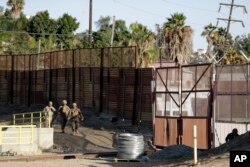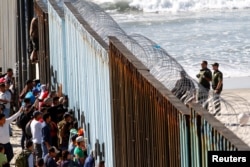The number of U.S. troops at the border with Mexico has reached its upper limit, top Pentagon officials said Thursday.
More than 5,800 active duty and 2,100 National Guard troops are currently deployed to help U.S. Customs and Border Protection strengthen barriers, build housing, operate aircraft and other activities intended to help the U.S. Border Patrol. Earlier, President Donald Trump said the force might be larger.
"We're pretty much peaked in terms of the number of people that are down there," Deputy Secretary of Defense Patrick Shanahan told reporters at the Pentagon.
The troops were sent to the U.S. southern border at the request of the Department of Homeland Security. Shanahan said the troops may stay through Dec. 15. The military is legally prohibited from domestic law enforcement, such as arresting migrants crossing the border.
In the meantime, several hundred Central American migrants arrived Wednesday in the Mexican border city of Tijuana after a month of traveling away from poverty and violence at home, in hopes of entering the United States.
About 800 migrants are now in Tijuana. Many said they would stay there and wait for the rest of their caravan to arrive and for leaders to advise them of their options for seeking asylum in the United States. Some of the early arrivals went to the border fence to celebrate.
The migrants in Tijuana got a generally warm greeting from locals, but some were met with hostility from an upper middle-class beach neighborhood.
Residents shouted, "You're not welcome!" and "Get out!" to a group of about 100 Central Americans. Police kept the two sides apart. One protester said the hostility had nothing to do with race, but with safety.
A Tijuana city official said the city is not prepared for such a large number of arrivals. Most migrant shelters are already full. The official said she hopes the Mexican federal government will offer the migrants asylum and jobs.
The bulk of the migrant caravan of about 4,000 people, mostly from Honduras, is making its way through the state of Sonora and is expected to arrive in Tijuana in a few days.
The San Ysidro port linking Tijuana to the U.S. city of San Diego, is the busiest crossing on the border. But it only processes about 100 asylum claims per day, meaning those in the caravan who seek that route face a long wait.
Trump has sharply criticized the caravans, casting them as a "national emergency."
He signed a proclamation last week declaring migrants who enter the country illegally ineligible for asylum. That goes against federal laws stating anyone is eligible for asylum, no matter how he or she entered the country.
The American Civil Liberties Union and other groups quickly filed a legal challenge and sought an injunction against the new rules while the case makes its way through the courts. A federal judge has set a hearing on the injunction for Nov. 19.
In addition to the caravan at or nearing the border, two others have made their way to Mexico City with more than 2,000 people.
Mexico said last week it had issued about 2,700 temporary visas to individuals and families, allowing them to work while their refugee applications proceed.
Kenneth Schwartz contributed to this report













